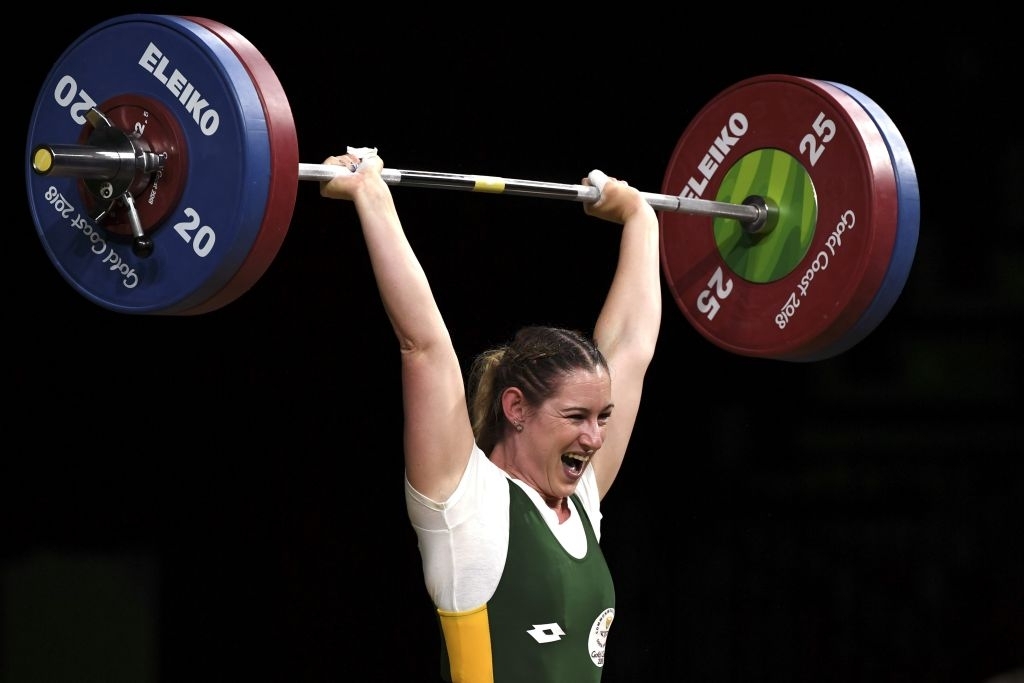The Hang Power snatch is a great assistance exercise in Olympic weightlifting with multiple purposes. Learning how to do the movements correctly can significantly enhance your full lifts. However, some athletes who do the sport of weightlifting as an assistant sport for their primary sport can use these movements to improve power and speed in their sport.
The hang power snatch is a great exercise to fix technical issues in the snatch. It’s also a great movement to build positional strength and teach you to stay over the bar as long as possible before completing the pull to get into the tall (triple extended) position.
Knowing how to do the hang power snatch with the proper technique can have multiple benefits for your classical lifts. We will be discussing how to do the hang power snatch and what to avoid.
Table of Contents
How To Hang Power Snatch
Starting Position
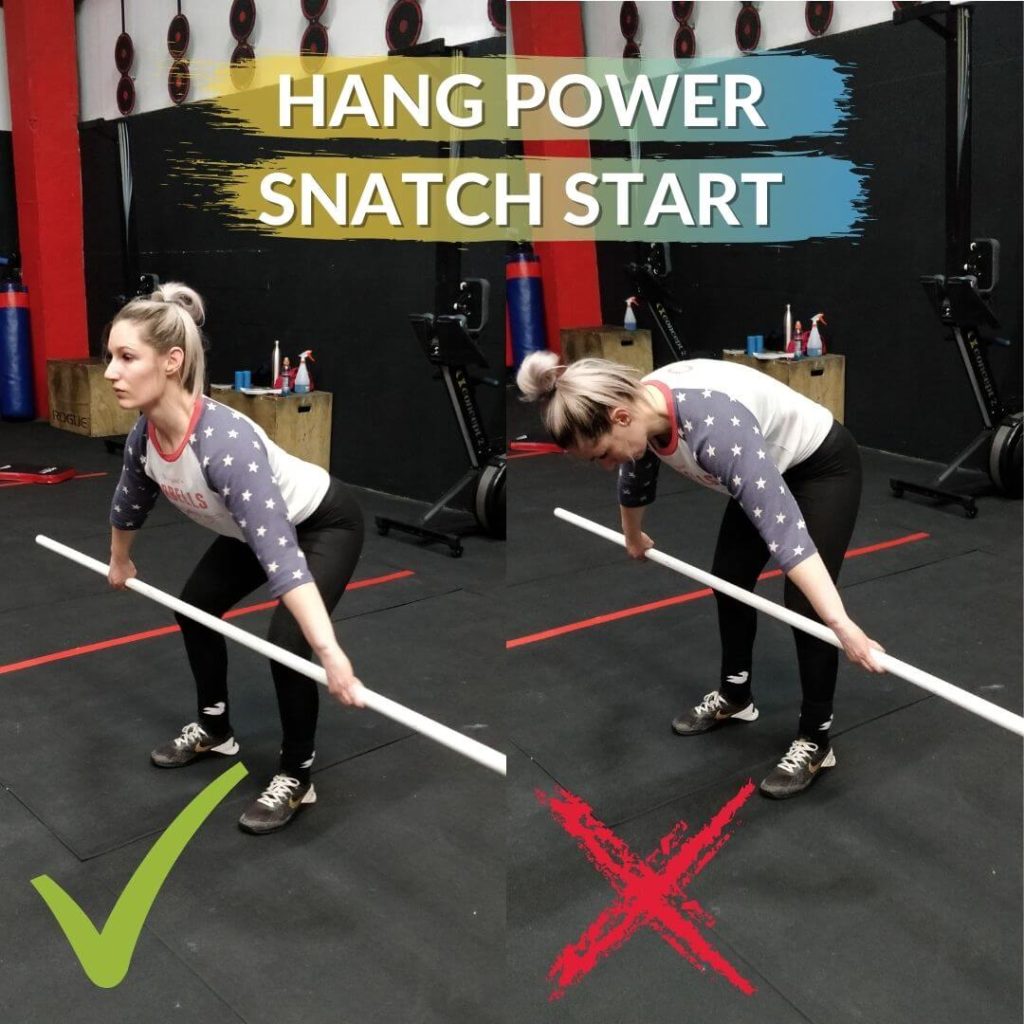
The starting position starts with the feet. When you start picking up the bar, it will be in the exact same place as the snatch. The only difference is you will pick the bar up to the hip and move down to the hang position above the knee, where the movement will start.
Foot position is generally slightly wider than hip-width, but this varies from person to person depending on your limb length. But, the general rule of thumb is just wider than your hips, with your toes either facing forward or slightly out.
If you are unsure where to grip the bar, when you stand up straight with the bar in your hands, the bar should be in the hip crease when you stand tall with the lats activated.
The hook grip is the preferred method of gripping the bar, but you can also use straps depending on your level.
When you pick the bar up with the hang power snatch, you want to make sure your lats are tight and activated, and your posture is good with a big chest (a posture of confidence). Keep the arms relaxed.
Pull
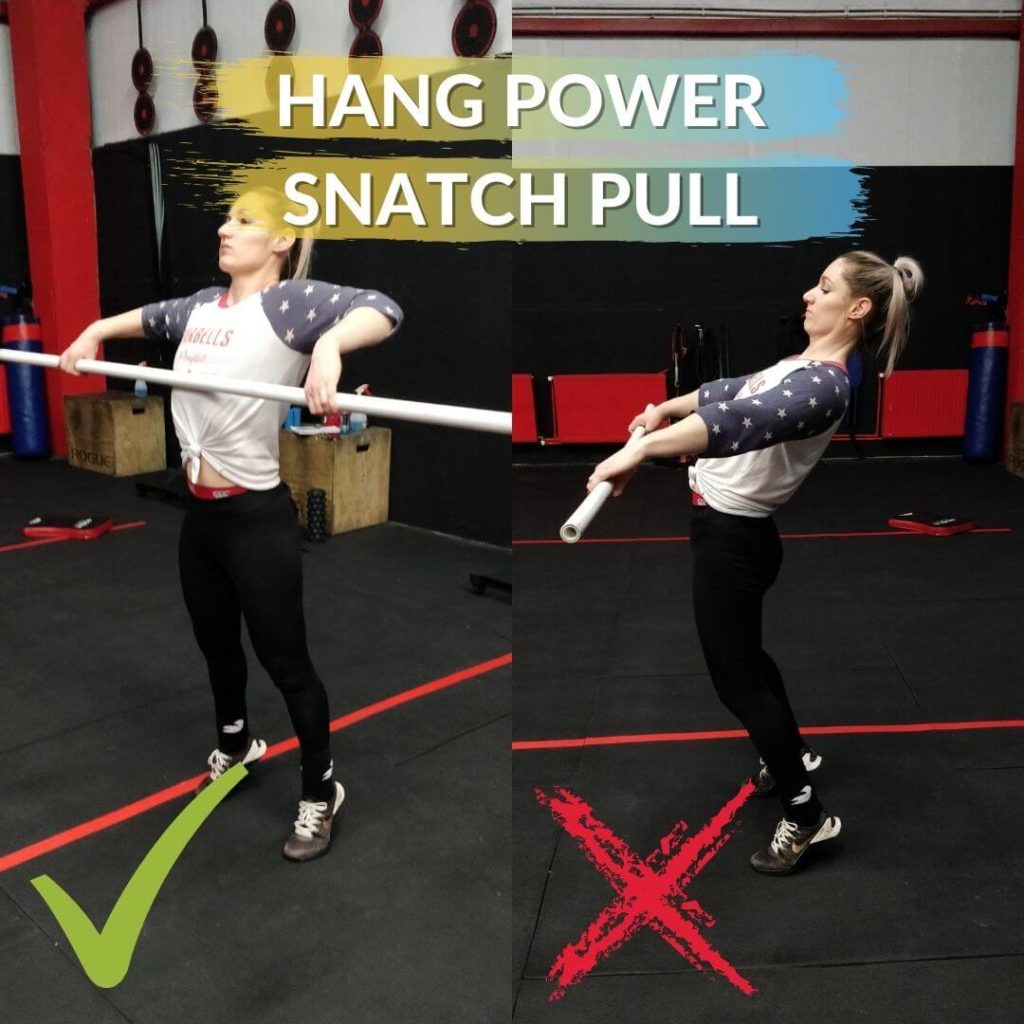
The pull for the hang power snatch will start from the hang position. Make sure you are not rushing the movement by building momentum when you move into the hang position and immediately start pulling.
Stop in the hang position for a second, make sure your foot pressure comes from the middle or whole foot, and drive the bar up with your legs. Stay over the bar as long as possible, keeping the bar close to the body with lats activated.
Once you reach full extension (triple extension or tall), brush the hip crease. You will then start pulling yourself under the bar, making sure you keep that bar close to the body.
Catch Position
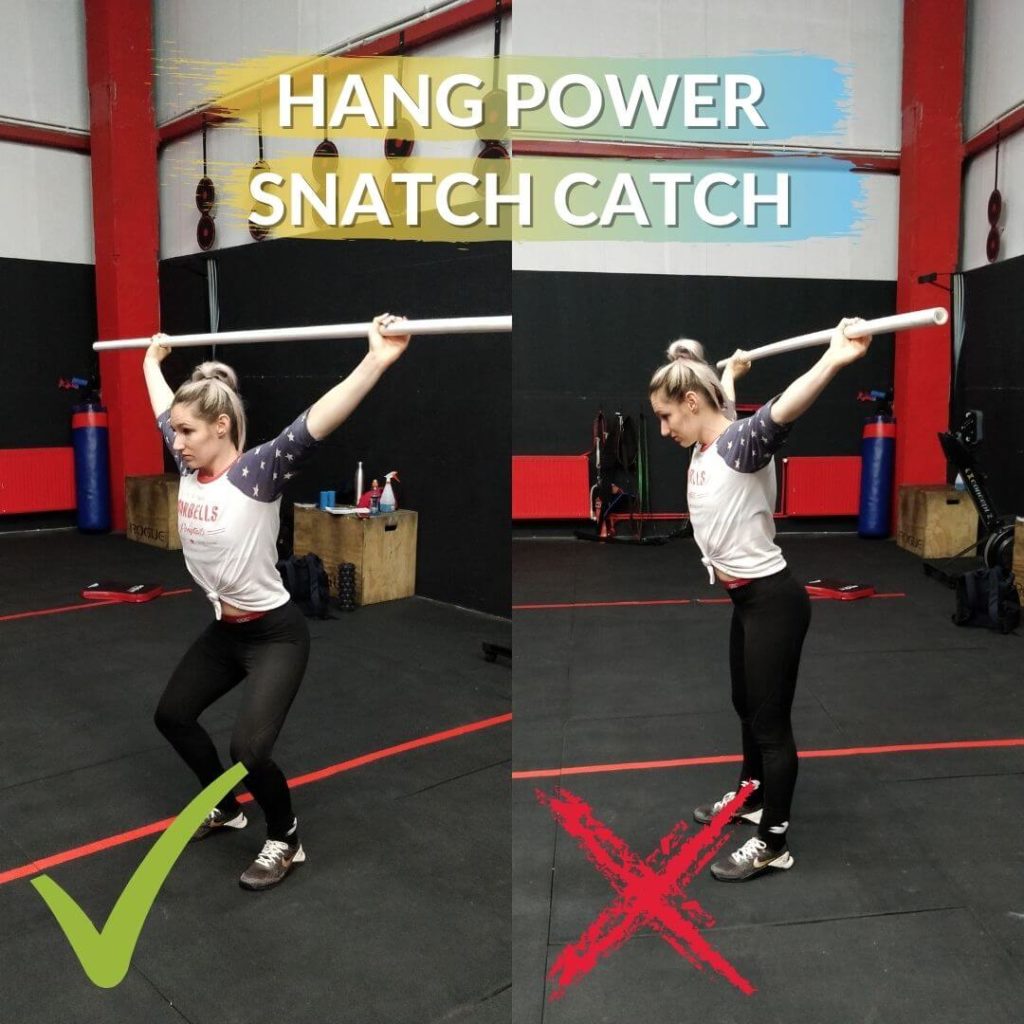
Once you start pulling yourself under the bar, you will begin to squat down but not all the way. We want to catch the bar above a 90-degree position (angle of the calves and hamstring) which is also called the power position in Olympic weightlifting.
You will then start pushing aggressively against the bar to punch it overhead when you land in your power position. Make sure everything is tight and solid at that very moment.
Hang Power Snatch Muscles Worked
The hang power snatch works every muscle group in the body. But the muscles that will do most of the work are the back and legs—especially the hamstrings when you are in the hang position. The upper back and lats keep the back tight and firm.
Hang Power Snatch Benefits
Emphasizes Positions
The hang power snatch emphasizes position in the high hang, hang, or below the knee hang. It will help you feel where the barbell should be in that position when you perform the full classical lifts.
It will also help you develop an awareness of how much aggression you need to put into the movement when you are at that point in the pull. It will also create awareness of how your hamstrings and back will feel in those positions.
Build Strength With Time Under Tension
Any movements from the hang are a great way to build strength in those positions. The hang power snatch will help you build strength in the back and legs when performing repetitions in that movement.
Practice Speed And Aggression Under The Bar
The hang power snatch is a great way to teach you speed and aggression when performing the movement above the knee. Emphasizing aggression and speed and making sure you get tall in the pull will help you generate more speed and force to pull yourself under the bar.
Practice Technique And Speed
The hang power snatch is a great way to help you learn how to move with the barbell above the knee. If you are a beginner athlete, it will help you feel and understand where the bar should be in the hang power snatch position.
Further, you’ll get the feeling of how the bar should be kept close to the body, brushing the bar against the hip crease, reaching that full triple extension and how to then pull yourself under the bar to land in the power snatch.
A Great Way To Teach Positions From The Top Down
By feeling where the bar should be in the position of the high hang, hang and below knee is extremely powerful when performing the hang power snatch.
Practicing the hang power snatch will help you feel where your body position should be and how much emphasis you should put on the pull when performing the hang power snatch.
Common Hang Power Snatch Mistakes
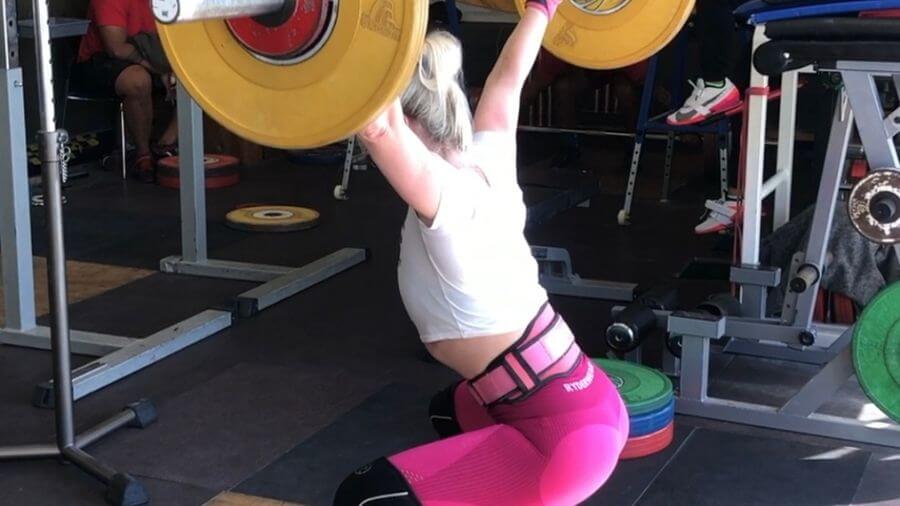
Using Momentum When Pulling By Pushing Your Knees Forward And Not Staying Over The Bar.
Pulling with momentum when performing the hang power snatch, also called a rocking hang power snatch, is a way to “cheat” to get under the bar. This will only work for a short period and will not have a good carry-over to the snatch when performing the classical movement.
You need to focus on staying over the bar as long as possible and driving the legs into the ground. At the same time, their lats are kept activated to then move into a fully extended position before pulling yourself under the bar.
Landing Too Wide In The Catch
Landing too wide in the catch with the hang power snatch is one of the most common mistakes when you see athletes who have come from CrossFit. They tend to want to pull and get under the bar as fast as possible with no technique in mind.
If you land too wide in the power snatch, you will not be able to squat down if the weight had to push you down into a full snatch. The landing for the hang power snatch should be identical to the landing of the snatch.
Not Completing The Pull
When you don’t complete their pull in the hang power snatch position, it will lead to either missing the bar forward or backward when the weight becomes heavy.
I like to use “full extension” or “tall” cues. This is an excellent way to get that full extended position and complete their pull. This way, you can use the entire body’s power to perform the hang power snatch.
Bouncing The Bar Off The Hips
Bouncing the bar of the hips in the hang power snatch is very common with beginner-level athletes who think that is the way to make hip contact. You need to brush the bar off the hip crease and keep the bar as close as possible to the body to perform the hang power snatch correctly.
When bouncing the bar off the hips will cause the bar to swing out, which will cause you to either jump forward or backward or miss the weight completely.
When To Use The Hang Power Snatch?
The hang power snatch can be used when you learn the different positions when starting to lift. It’s a great way to break the movement down into segments.
The hang power snatch can also be used to build strength in certain positions, especially the hang position to make their backs strong.
Generally, you cannot go as heavy with the hang power snatch as you would with a hang snatch. This means you can do it on your lighter days to work some extra speed and technique by letting your body recover from the full lifts.
Use the hang power snatch on days commonly between your heavier, classical lift days.
How Many Sets And Reps Of The Hang Power Snatch?
Generally, a good set and rep range would be 4-6 Sets of 1-3 repetitions at 50-70% of your 1RM Snatch.
Hang Power Snatch Variations
No Feet
No feet hang power snatch is done precisely the same way as what you would do a hang power snatch; the only difference is you will not be extending to a point where you are airborne and jump out with your feet.
With the no feet variation, you keep your feet still in that position, and they might slide out a bit, but you generally try and keep them as still as possible to focus on getting a full extension in the pull.
This is an excellent exercise if you are battling to complete their pull in the traditional hang power snatch.
Clean Grip Hang Power Snatch
Clean Grip hang power snatch is another excellent variation to teach athletes to complete the pull before pulling themselves under the bar.
If you are battling with mobility and cannot do the movement in the clean Grip, I always advise them to either move a fist-width in from their snatch or do this until they are comfortable and mobile enough to perform the hang power snatch in the clean Grip.
High Hang Power Snatch
The high hang power snatch is used to teach a beginner weightlifter from the top (hip) down (hang, hang below knee and floor).
It teaches you to focus on the full extension and pulling themselves under the bar without the other components of keeping the bar close to the body and brushing the bar against the thighs etc.
As an intermediate and advanced level athlete, the high hang power snatch is a great exercise to work speed and technique and pull themselves aggressively under the bar. You will have no extra momentum as they could have from a hang position, so the hang power snatch will generally perform this exercise with a much lighter weight.
Hang Below-Knee Power Snatch
They hang below the knee power snatch is another added variation to the beginner weightlifter. After learning how to high hang power snatch and hang power snatch, this exercise will be the progression.
With regards to intermediate or advanced level weightlifters, the hang power snatch below the knee is a great exercise to do to develop extra back strength, to learn how to move the knees out of the way yet still staying over the bar as long as possible and building strength with the time under tension.
Hang Power Snatch With Pause
The hang power snatch with a pause in the hang position is a great way to teach athletes who use momentum to pull themselves under the bar not to use any momentum. This way, they can build strength in the hang position and learn to stay over the bar longer, and drive with the legs to reach a fully extended position before pulling themselves under the bar.
Summary
The hang power snatch is a great exercise to do no matter your level. It can be used for numerous purposes or goals in mind and can also be used to teach how to lift when they are a beginner athlete and work speed and technique as an advanced-level athlete.
Moving correctly with a hang power snatch can be a powerful tool to help your classical snatch. Don’t aim to go too heavy with this exercise and risk deviating from the proper technique. The technique is always one of the main focus points when performing assistant exercises.

